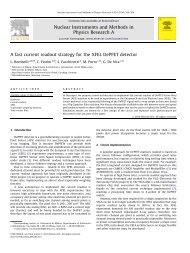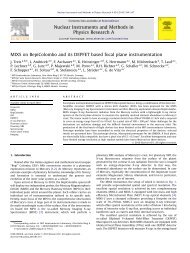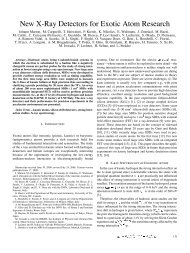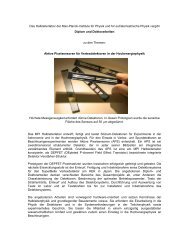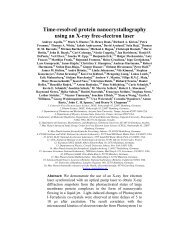Design and technology of DEPFET pixel sensors for ... - MPG HLL
Design and technology of DEPFET pixel sensors for ... - MPG HLL
Design and technology of DEPFET pixel sensors for ... - MPG HLL
You also want an ePaper? Increase the reach of your titles
YUMPU automatically turns print PDFs into web optimized ePapers that Google loves.
4Asourcedrain_1gate_2clearclear gateAclear gatedrain_2gate_1P+ implantN+ implantPolySilicon_1PolySilicon_2Contact_1Contact_2Metal_1Metal_2Fig.4: Layout example <strong>for</strong> a linear double <strong>pixel</strong> cell. Each whiterectangle surrounds a DEPMOS.For larger area sensor arrays, the availability <strong>of</strong>more than one metal layer is m<strong>and</strong>atory due to thenecessity <strong>of</strong> the row- <strong>and</strong> column-wise connections<strong>of</strong> the <strong>pixel</strong>s. At the Semiconductor Laboratory <strong>of</strong> theMax-Planck-Institutes, a 150mm silicon <strong>technology</strong><strong>for</strong> MOS type <strong>DEPFET</strong>s on high ohmic substrateswith two polysilicon <strong>and</strong> two metal layers has beendeveloped. Using the two polysilicon layers, linearDEPMOS transistors can be fabricated whereby thefirst polysilicon <strong>for</strong>ms a lateral isolation frame <strong>and</strong>the second one is used <strong>for</strong> the external gate <strong>of</strong> the<strong>DEPFET</strong>. This approach is different from that used incommon MOS technologies, where the lateraltransistor isolation is provided by locally oxidizedfield regions or shallow trenches filled with oxide.The channel isolation structure <strong>of</strong> the <strong>DEPFET</strong>s mustnot collect signal electrons <strong>and</strong> has to accomplish theintegration <strong>of</strong> the clear contacts.Fig.5: Potential distribution across the section A-A in Fig.4during the clear operation simulated with the 3D-Poisson solverPoseidon [18] (VClear = 20V, VBack = -30V, VSource = 0V,VDrain = -5V, VGate = -3V, VClear-Gate = 1V).The n+ doped clear region is close-by the internalgate, separated only by the first polysilicon layer. Inthe Collect <strong>and</strong> Read modes, the region underneaththe polysilicon acts as a potential barrier between theclear region <strong>and</strong> the internal gate. The barrier has tobe overcome during the Clear cycle when the clearcontact gets positive. The first polysilicon acts notonly as an isolation frame but also as a reset (clear)gate. It is held at a constant potential or can beswitched in order to alleviate the clear process. Asshown in Fig.4, the linear cell geometry allows <strong>for</strong> avery compact <strong>pixel</strong> layout free from potential pocketswhere the signal charge could disappear (see alsoFig.6). In any case, the implanted drain, source <strong>and</strong>clear regions are shared by neighboring cells. In thisway a small <strong>pixel</strong> size is achievable even with ratherrelaxed lithographic requirements. This feature,which defines also the tolerable defect size in theprocess, is important concerning the yield <strong>of</strong> largearea detectors.We have started a production run on 6-inch waferscontaining prototype arrays <strong>of</strong> up to 128x64 <strong>pixel</strong>s<strong>for</strong> high energy <strong>and</strong> astrophysical applications [13-15]. The smallest <strong>pixel</strong> cell size is presently30x20µm².


